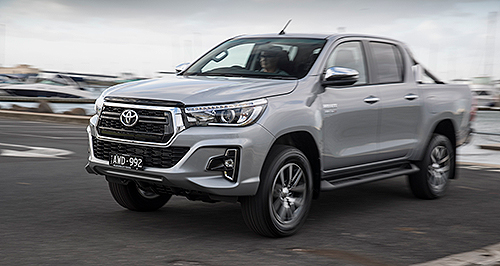Make / Model Search
News - General News - EmissionsAustralia’s car CO2 emissions remain highCoughing it up: As Australia’s car emissions reduction continued to stall last year, the NTC report reveals that US EV brand Tesla’s sales dropped by a significant 23 per cent, to 1005 units. Mild 0.4 per cent fall in vehicle emissions in 2018 as SUV, ute love affair rolls on30 Aug 2019 By TERRY MARTIN THE average carbon dioxide emissions from new light vehicles sold in Australia has continued to stagnate, with the National Transport Commission (NTC) releasing figures overnight that show only a 0.4 per cent improvement was achieved last year.
Covering all new passenger cars, SUVs and light-commercial vehicles, the national emissions intensity performance of 180.9 grams of CO2 per kilometre stands as the second-lowest annual improvement recorded since records started in 2002, with the previous year’s result – 0.3 per cent in 2017 – remaining the lowest rate of reduction.
As it has done for the past several years, the result throws the spotlight back on government policy – or lack thereof – in areas such as long-mooted mandatory CO2 targets and other initiatives such as supporting the uptake of low-emissions vehicles, particularly EVs, with subsidies and other incentives.
The industry is continuing to move in the right direction, but the rate of change remains painfully slow, with the annual reduction less than two per cent for four years in a row – and just 3.3g/km in total from 2015 to 2018.
Last year’s shallow improvement also came in the first full year without Australian car manufacturing, which had an immediate impact in lowering the average CO2 emissions of large cars by 14.5 per cent, from 236g/km to 202g/km, as sales dwindled with the depleted supply.
But this did not make any serious dent in the overall result as Australian buyers continued to steer in droves towards SUVs and utes – typically larger, heavier and therefore higher-polluting vehicles that keep the national average emissions figure high compared to other markets.
The NTC figures also show for the first time that Tesla Motors sold 1005 EVs last year, adding to the 1352 sold by FCAI members for a total EV market of 2357 units – down three per cent on the 2424 sold in 2017.
For Tesla, this was a 23 per cent fall from the 1300 units sold in 2017.
Furthermore, there were fewer ‘green’ models (<120g/km) available on the market last year – 93 compared to 97 in 2017 – and these represented only 4.1 per cent of total sales, up from 3.8 per cent a year earlier.
According to the NTC, if all Australians who purchased a new vehicle last year chose the one with best-in-class emissions, the overall CO2 intensity would have been just 73g/km – a 60 per cent reduction.
However, the overwhelming majority (91%) of all new-vehicle sales in 2018 came from just 15 brands.
Of these, Audi had the lowest emissions at 148g/km (+1.7%) and Ford the highest at 216g/km (+0.4%), while market leader Toyota came in at 197g/km, up 0.1 per cent despite increasing its hybrid powertrain offerings.
Private buyers purchased vehicles with the lowest CO2 intensity (174g/km), with business operators next (186g/km) and government further up the scale (195g/km).
Drill down further into the figures, which are based on data provided by the Federal Chamber of Automotive Industries (FCAI), and emissions intensity results for a number of top-selling and/or fast-growing segments – including small and mid-size SUVs and 4x4 utilities – went in the wrong direction, rising as their popularity increases and competition heats up with more new models and variants and a dearth of ultra-low-emissions options for consumers.
As SUV sales lifted 6.4 per cent last year to dominate the market with a 43 per cent share, their average emissions climbed across three major categories: small (157g/km, +0.9%), medium (174g/km, +0.6%) and the highest-emitting category across the industry, upper-large (259g/km, +0.8%).
Large SUV (207g/km, -0.6%) was the only high-riding class to fall, while in overall terms the SUV sector was down 0.4 per cent to 181g/km.
Emissions across the entire light-commercial sector increased by 0.1 per cent last year, from 221.1g/km to 221.5g/km, with the high-volume 4x4 pick-up segment incurring a 0.5 per cent rise to 224g/km.
Toyota’s HiLux ute, which was the top-selling vehicle in Australia last year, stands at 238g/km and 220g/km for the 4x2 and 4x2 versions respectively – well above the best-in-class diesel-powered Nissan Navara rated at 166g/km (4x2) and 147g/km (4x4).
Australia remains a long way behind Europe in overall terms, with the NTC data – based on 2017 figures – placing the EU at 118.5g/km for passenger cars and SUVs combined, 45 per cent lower than in this country (171.5g/km).
With LCVs, the EU’s comparable figure for 2017 was 156g/km – 42 per cent lower than in Australia (221g/km).
As it has done in previous years, the NTC lists a number of obvious reasons why we are so far behind Europe, including: consumer preferences here for heavier vehicles with larger and more powerful engines; a lower proportion of diesel-powered engines here; fewer government incentives for lower-emissions vehicles; and relatively lower fuel prices in Australia compared with Europe.  Read more12th of June 2018  Australian average CO2 reduction continues to stallSUV popularity continues to slow reduction of average CO2 emissions in Australia5th of June 2017  Aussie consumer trends slowing CO2 reductionNew cars getting cleaner but not a focus for Australian consumers, says report2nd of April 2016  Rate of new-car emissions decline stallsTailpipe emissions in Australia on downward trend but 4g/km drop no better than 20142nd of April 2016  Market Insight: Mixed CO2 results for top brandsNissan improves most, but still at back of field, in latest NTC CO2 report card |
Click to shareGeneral News articlesResearch General News Motor industry news |











Facebook Twitter Instagram